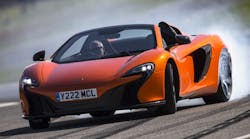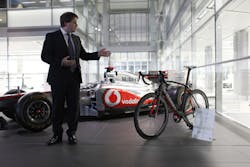The floor cleaning machine is making a slow sweep back and forth over the gleaming white tile of the McLaren manufacturing floor. It is the only machine on the floor designed to travel at such a stately pace, for this is the manufacturing site of automobiles such as the McLaren P1, a 217-mph hybrid supercar that can travel from 0 to 60 in 2.6 seconds and costs $1.2 million.
Those who still believe manufacturing is dirty and dark should visit the McLaren Technology Centre in Woking, Surrey, England, which is less Henry Ford Rouge Plant than Apple showroom. An appreciation for style is omnipresent, from the curving lines of the Norman Foster-designed building to the array of powerful Formula 1 and production road cars produced by McLaren that line the front of the building.
Included in the collection is the car that founder Bruce McLaren won his first race in, at age 15. Today’s FI cars may have 135 sensors constantly monitoring the performance of the car and feeding information to the driver and his team. The tiny roadster had one sensor – a temperature gauge that showed the engine as cool or normal.
Clearly, McLaren operates in the realm of the elite. Production staff wear Hugo Boss uniforms. The company cafeteria serves food from McLaren’s own catering firm, called Absolute Taste, whose main business is serving sponsors and other dignitaries at Grand Prix events. As for its clientele, a Chinese buyer recently visited McLaren and offered them cash for a P1. He was told that the car was sold out and was offered a 650S, which starts at $265,000, as an alternative. No, said the prospective customer, that was not expensive enough.
But McLaren’s elitism is firmly grounded in an obsession with performance and continuous improvement, qualities that any world-class manufacturer can appreciate. So, while the factory’s spotless production floor is aesthetically pleasing, it also has its practical value.
“It is designed to limit problems with foreign objects. As soon as something is dropped or spilled, it is cleaned up because it is obvious,” explained Ben Heatley, group corporate PR manager for McLaren.
Unlike other racing companies, McLaren keeps each of its FI cars after they are retired from a season. The cars not only make up the headquarters collection, but each McLaren dealership has an FI machine on its showfloor.
This appreciation for the company’s history may stem from the fact that it was almost snuffed out in 1970 when company founder Bruce McLaren died at age 32 while testing one of his cars.
“At that point in time, he was the owner of the team, the driver, the chief mechanic, the chief engineer. Everything was built around him with only 20 to 25 additional guys,” said Heatley. “Nobody had any idea the company would even continue.”
But in fact, McLaren has thrived in the ensuing years. The company now has 2,000 employees working in six areas – the Formula 1 racing team, road car manufacturing, electronic systems, marketing, Absolute Taste and a growing consulting division called McLaren Applied Technologies. In 2013, the automotive group had revenue of $483 million.
Continuous Improvement Under Pressure
Formula 1 is “all about continually seeking to improve very quickly,” said Heatley. Teams must analyze results from the previous race, build new parts and install them and prepare for the next race, all in the space of two weeks.
McLaren manufactures a new part for its Formula I cars every 17 minutes - 24 hours a day, seven days a week. On the day IndustryWeek visited the facility, parts were being finished for an upcoming race in Canada. Members of the marketing team were carrying suitcases onto their flights with components for the race team.
Heatley said the F1 car should be thought of as a prototype that is evolving constantly throughout the race season. The car that the team ends up with in November is 70% to 80% different than the car that started the season in March. “It is an engineering race as much as a driving race,” observed Jim Newton, market development director for McLaren Applied Technologies.
“We are always learning lessons from the data we collect at the track and how we can improve it. We also tailor the car from track to track. The aerodynamics for Monaco, for example, are radically different than for Monza, which is very, very fast,” said Heatley.
The technology center has a wind tunnel in which prototypes sized at 60% of production cars are tested. The wind tunnel building structure is isolated from the rest of the complex so that the vibration from testing does not disturb precision operations going on elsewhere. Using the smaller scale vehicles cuts down on the amount of carbon fiber used and the amount of energy needed to run the wind tunnel.
Water from the lake in front of the facility is run through turbines to generate heat and cooling, and is also used to help cool the wind tunnel.
The process of constant improvement extends even to pit stops. There is a pit stop station with cameras pointed at the front and rear of a 2012 car. When the race teams are at headquarters, they will come over to the station twice a day and run a full pit-stop for 20 minutes at a time. Each practice is recorded and analyzed to look for ways to make the stops faster. Currently, McLaren owns the world record of performing a pit stop in 2.31 seconds. The company is hoping to break the 2-second mark during the current race season.
Heatley said the F1 manufacturing is much more efficient than in previous years because computer simulation is used first before the parts are tested and actually produced. In the past, he said, 90% of the parts produced were discarded because they did not help performance. Now, he said, only 10% are thrown away.
In 1992, McLaren added road production cars to its Formula 1 business when it launched its F1 sports car, which featured an unusual seating arrangement of the driver’s seat in the middle and two passenger seats flanking it and positioned slightly to the rear. The car, which has a 0 to 60 mph time of 3.0 seconds, cost just under $1 million. One of the cars recently sold for more than $11 million. Only about 100 of the cars were built and it remains the fastest normally aspirated engine-powered car in the world.
One of the reasons so few cars were built, noted Newton, is that it couldn’t be certified in a number of markets because regulators couldn’t decide if it was left- or right-hand drive.
McLaren has declared that it will develop a new car model each year. That is the primary reason it is keeping its engineering and manufacturing staffs in close proximity.
“We don’t want our manufacturing to happen in Asia and have our engineers here. With our innovation cycle and product development cycle, that becomes untenable.” said Heatley.
In McLaren’s production center, two models currently are being manufactured – the 650S and the P1. The 650S was launched earlier this year and there are orders for about 1,000 cars. Those orders have pushed the firm’s production backlog from about 6 months to 9 to 12 months, but the company is working to whittle down that backlog.
Unlike its higher-volume cousins, McLaren does much of its manufacturing by hand, allowing it both to keep its investment in production tooling low and to provide flexibility for model changes. The company, which operates one shift, takes about 23 days to build a 650 or P1. As volumes of its cars increase, officials plan to add additional shifts rather than expand the production floor.
Underneath the main production floor is another floor where logistics and sub-assembly work takes place. All told, about 500 workers are involved in building McLaren sports cars.
The 650S starts life as a carbon fiber monocell. An aluminum crash structure is bolted on to the front and back of the car. Farther up the line, it is determined if the car will be a coupe or spider, and if it will be right- or left-hand drive. At that point, it enters a test area where approximately 400 geometric validation points are measured. Engines are supplied to McLaren by Ricardo from its facility in Shoreham, England.
Heatley said McLaren is the largest volume builder of carbon fiber car bodies. With experience has come advances in efficiency. McLaren used to take 1,000 hours to build the carbon fiber tub for the F1; now, the company takes 4 hours to build the tub of the 650S.
With the P1 reaching 0 to 60 in 2.6 seconds, officials say future car development will not focus solely on top speeds, but rather like FI, will focus on overall performance. “It will be a mixture of efficiency, drivability and performance. It will be the same level of performance as we have now, but with lighter materials, better handling, and more efficient engines,” said Heatley.
In seeking to fuel that development, the company shares the concern of many other engineering and manufacturing firms about attracting talent.
“McLaren is still best known for Formula 1 and road cars. People see the brand and think all we need are mechanical engineers. In my part of the business, I need quantum physicists, software guys, designers. I need a pretty wide range of skills,” said Newton, adding that McLaren is located in one of the most expensive areas of England and an area with very low unemployment.
Applied Technologies was started in part to keep talented employees from leaving the company. Heatley noted that while F1 is glamorous and interesting, it is also a hard lifestyle of 22 weeks a year on the road. Applied Technologies provides employees with an alternative that can be more family friendly. Perhaps not surprisingly, turnover is not a problem at McLaren. Officials say employee turnover is less than 1% for the Formula 1 workers and 1% to 2% for auto production.
The gleaming production center is an inviting space for McLaren customers who come to visit the facility while their car is being built. Newton estimated that 60% to 70% of customers visit the facility.
“They like to talk to our engineers,” Newton said. “A lot of our buyers are interested in the technology and engineering of the vehicles as well as what it looks like and how it performs.”
Looking at the cars being assembled on the line, Heatley notes that color choices fall broadly along regional lines. Customers from Asia and the Middle East tend to pick white and bright colors, while European buyers more often choose darker, more muted colors.
“America tends to be more the classic sports car colors – the vibrant reds, oranges, yellows. The McLaren orange sells very well in America,” said Heatley.
McLaren is building only 375 P1 cars, all of which are sold. Some of the FI racing DNA of McLaren is evident in the P1’s brake-steer system, which was introduced in its racing cars in the 1990s. The cars featured an extra pedal which you depressed going into corners and it braked the inside wheels to smooth out the car’s steering line. The proactive chassis could be raised by 100 millimeters so, for instance, you could go over speed bumps in town without damaging the car.
The company’s road cars benefit from the advances pioneered in its F1 racing vehicles. For example, the 1993 car driven by the late Ayrton Senna used an active right-height adjustable suspension and won five races. Driver opinions were split on this technology – some liked the fact the suspension was self-adjusting, giving them one less thing to worry about, but others felt it robbed them of full control of the car. This computerized suspension was banned by F1.
“In terms of electronic driver aids – active suspension, traction control and so on – this is probably the car that had the most electronic toys on it. A lot of that technology is coming back around and is now on our new road cars,” said Heatley.
If for some reason a customer doesn’t like a “standard” McLaren, never fear – there are 6 million possible options for the cars. And that is before McLaren Special Operations comes into the picture. In at least one case, they designed a car that used the standard engine and inner structure, but the design of the car was completely new and unique.
While McLaren does take customer feedback into account as it develops new cars, Heatley said, “The starting point is always technology. We want to build the world’s best car and we trust there is a market for people who want to buy the world’s best car.”
Partnerships to Push Performance
McLaren Applied Technologies is an arm of the company that brings the firm’s technology and expertise to bear on other products and industries. The company typically develops long-term technology development partnerships with companies, sharing in the proceeds of improved products.
For example, in the company’s product gallery is a bicycle that came out of a development partnership with Specialized, the bicycle manufacturer headquartered in Morgan Hill, Calif.
When McLaren approached Specialized, they presented the company with a simple challenge.
“Take our best bike at the time, the Venge, and make it better,” recalled Heatley. “Make it stiffer and lighter.” Normally, he said, the two are mutually exclusive – a frame becomes stiffer as you add more material to it.
“The first thing we asked them was, ‘Why do you think stiffer and lighter would mean faster?’” he said.
McLaren set to work, putting sensors on bikes, conducting research and performing data analytics.
“What we have done is to characterize terrain, bike and rider as a dynamic system mathematically. The company can use modeling to analyze these three elements and determine how fast a particular combination will be,” said Newton
The S-Works version of the Venge had a different type of carbon fiber structure that was 20% lighter and 10% stiffer, and was designed specifically for Mark Cavendish, a British rider. The bike was launched on a Thursday and won a race in San Remo on the following Saturday.
“We call it data-driven design. Rather than just designing a prototype and see if it is fast, we like to measure with sensors a particular situation and then design what would be optimum,” explained Newton.
The company has taken this approach to a range of other industries, including oil and gas, pharmaceuticals and data centers. McLaren is working with IO Datacenters to design more energy-efficient data centers. The company is applying its experience with the real-time analysis of sensor data to health care, working with clients such as GSK to better understand the condition of patients participating in clinical trials.
McLaren also works with high-volume manufacturers to better understand their processes and increase capacity. As with other areas, McLaren doesn’t focus specifically on machinery or on processes such as Six Sigma, but “we consider people, equipment and the environment as a system.” For example, on McLaren’s line, equipment stacks are kept below chin height so that employees can see each other and communicate more readily. This also helps floor managers more easily see what is going on and spot any production bottlenecks.
“It’s natural selection in western manufacturing,” said Heatley. Successful manufacturers have not only rethought how they manufacture and deploy technology, he said, but also the way they manufacture things in order to compete with lower wage economies. He noted, “Labor is a shrinking proportion of the value chain.”
For McLaren, an analytical approach to engineering and manufacturing combined with an employee-friendly work environment is reaping handsome rewards for one of the riskiest undertakings in Western manufacturing – starting a car manufacturer.
“Hopefully, part of what we have done is demonstrate that you can start a new car company and do quite well,” said Heatley.







